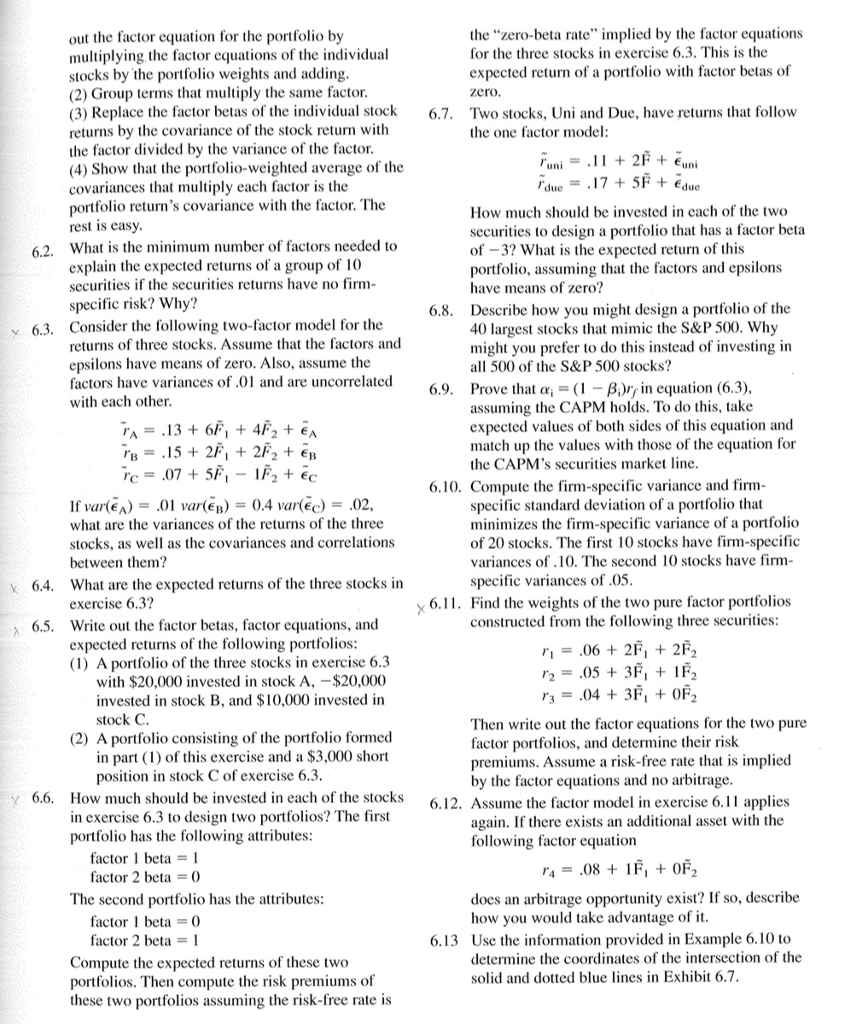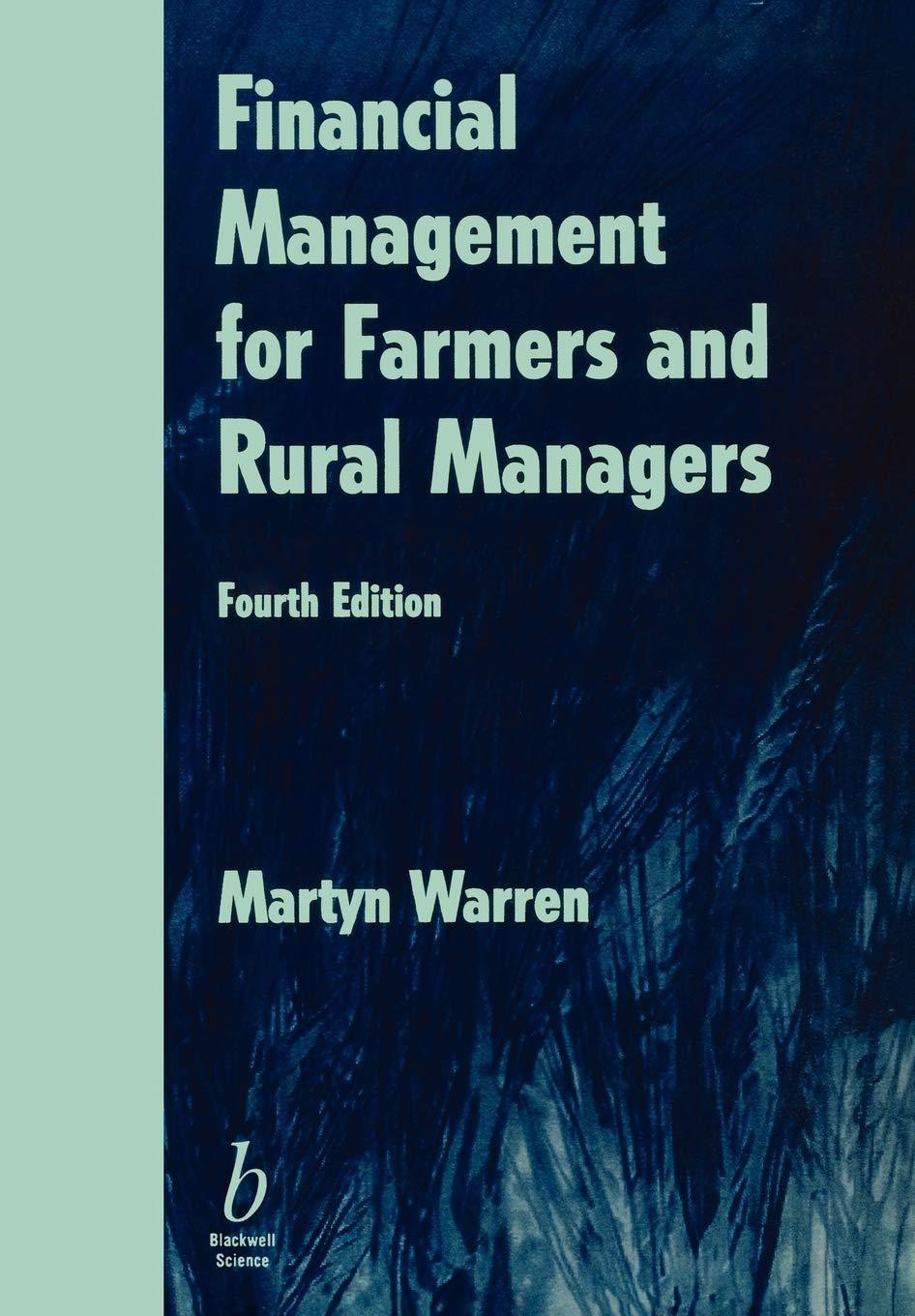Answered step by step
Verified Expert Solution
Question
1 Approved Answer
Question 6.6. the zero-beta rate implied by the factor equations for the three stocks in exercise 6.3. This is the out the factor equation for

Question 6.6.
the "zero-beta rate" implied by the factor equations for the three stocks in exercise 6.3. This is the out the factor equation for the portfolio by multiplying the factor equations of the individual stocks by the portfolio weights and adding (2) Group tems that multiply the same factor (3) Replace the factor betas of the individual stock returns by the covariance of the stock return with the factor divided by the variance of the factor (4) Show that the portfolio-weighted average of the covariances that multiply each factor is the portfolio return's covariance with the factor. The rest is easy What is the minimum number of factors needed to explain the expected returns of a group of 10 securities if the securities returns have no firm- specific risk? Why? Consider the following two-factor model for the returns of three stocks. Assume that the factors and epsilons have means of zero. Also, assume the factors have variances of .01 and are uncorrelated with each other expected return of a portfolio with factor betas of zero. Two stocks, Uni and Due, have returns that follow the one factor model: 6.7. ue How much should be invested in cach of the two securities to design a portfolio that has a factor beta of -3? What is the expected return of this portfolio, assuming that the factors and epsilons have means of zero? 6.2. Describe how you might design a portfolio of the 40 largest stocks that mimic the S&P 500. Why might you prefer to do this instead of investing in all 500 of the S&P 500 stocks? 6.8. 6.3. 6.9. Prove that a B)in equation (6.3), assuming the CAPM holds. To do this, take expected values of both sides of this equation and match up the values with those of the equation for the CAPM's securities market line. 6.10. Compute the firm-specific variance and firm what are the variances of the returns of the three stocks, as well as the covariances and correlations between them? specific standard deviation of a portfolio that minimizes the firm-specific variance of a portfolio of 20 stocks. The first 10 stocks have firm-specific variances of.10. The second 10 stocks have firm- specific variances of .05 6.4. What are the expected returns of the three stocks in Find the weights of the two pure factor portfolios constructed from the following three securities: exercise 6.3? Write out the factor betas, factor equations, and expected returns of the following portfolios: (1) A portfolio of the three stocks in exercise 6.3 6. 6.5. i-.06 + 2F, 2F2 r2-.05 + 3F, IF2 with $20,000 invested in stock A,-$20,000 invested in stock B, and $10,000 invested in Then write out the factor equations for the two pure factor portfolios, and determine their risk premiums. Assume a risk-free rate that is implied by the factor equations and no arbitrage (2) A portfolio consisting of the portfolio formed in part (1) of this exercise and a $3,000 short position in stock C of exercise 63 6.6. How much should be invested in each of the stocks 6.12. Assume the factor model ercise 6 app ercise 6.3 to design two portfolios? The first additional asset with the agai following factor equation cre portfolio has the following attributes factor 1 beta 1 factor 2 beta 0 r08IF, 0F2 does an arbitrage opportunity exist? If so, describe how you would take advantage of it The second portfolio has the attributes: factor 1 beta 0 factor 2 beta 6.13 Use the information provided in Example 6.10 to Compute the expected returns of these two portfolios. Then compute the risk premiums of these two portfolios assuming the risk-free rate is determine the coordinates of the intersection of the solid and dotted blue lines in Exhibit 6.7 the "zero-beta rate" implied by the factor equations for the three stocks in exercise 6.3. This is the out the factor equation for the portfolio by multiplying the factor equations of the individual stocks by the portfolio weights and adding (2) Group tems that multiply the same factor (3) Replace the factor betas of the individual stock returns by the covariance of the stock return with the factor divided by the variance of the factor (4) Show that the portfolio-weighted average of the covariances that multiply each factor is the portfolio return's covariance with the factor. The rest is easy What is the minimum number of factors needed to explain the expected returns of a group of 10 securities if the securities returns have no firm- specific risk? Why? Consider the following two-factor model for the returns of three stocks. Assume that the factors and epsilons have means of zero. Also, assume the factors have variances of .01 and are uncorrelated with each other expected return of a portfolio with factor betas of zero. Two stocks, Uni and Due, have returns that follow the one factor model: 6.7. ue How much should be invested in cach of the two securities to design a portfolio that has a factor beta of -3? What is the expected return of this portfolio, assuming that the factors and epsilons have means of zero? 6.2. Describe how you might design a portfolio of the 40 largest stocks that mimic the S&P 500. Why might you prefer to do this instead of investing in all 500 of the S&P 500 stocks? 6.8. 6.3. 6.9. Prove that a B)in equation (6.3), assuming the CAPM holds. To do this, take expected values of both sides of this equation and match up the values with those of the equation for the CAPM's securities market line. 6.10. Compute the firm-specific variance and firm what are the variances of the returns of the three stocks, as well as the covariances and correlations between them? specific standard deviation of a portfolio that minimizes the firm-specific variance of a portfolio of 20 stocks. The first 10 stocks have firm-specific variances of.10. The second 10 stocks have firm- specific variances of .05 6.4. What are the expected returns of the three stocks in Find the weights of the two pure factor portfolios constructed from the following three securities: exercise 6.3? Write out the factor betas, factor equations, and expected returns of the following portfolios: (1) A portfolio of the three stocks in exercise 6.3 6. 6.5. i-.06 + 2F, 2F2 r2-.05 + 3F, IF2 with $20,000 invested in stock A,-$20,000 invested in stock B, and $10,000 invested in Then write out the factor equations for the two pure factor portfolios, and determine their risk premiums. Assume a risk-free rate that is implied by the factor equations and no arbitrage (2) A portfolio consisting of the portfolio formed in part (1) of this exercise and a $3,000 short position in stock C of exercise 63 6.6. How much should be invested in each of the stocks 6.12. Assume the factor model ercise 6 app ercise 6.3 to design two portfolios? The first additional asset with the agai following factor equation cre portfolio has the following attributes factor 1 beta 1 factor 2 beta 0 r08IF, 0F2 does an arbitrage opportunity exist? If so, describe how you would take advantage of it The second portfolio has the attributes: factor 1 beta 0 factor 2 beta 6.13 Use the information provided in Example 6.10 to Compute the expected returns of these two portfolios. Then compute the risk premiums of these two portfolios assuming the risk-free rate is determine the coordinates of the intersection of the solid and dotted blue lines in Exhibit 6.7Step by Step Solution
There are 3 Steps involved in it
Step: 1

Get Instant Access to Expert-Tailored Solutions
See step-by-step solutions with expert insights and AI powered tools for academic success
Step: 2

Step: 3

Ace Your Homework with AI
Get the answers you need in no time with our AI-driven, step-by-step assistance
Get Started


